
After much deliberation, I gave in to creating a Foursquare account. The reason for my hesitant uptake boils down to one reason: I don't think it's a great investment of one's time. Stripping away the badges and points (which makes the game engaging for users), it's just Twitter...only for your location. However, after test-driving it, I've discovered that Foursquare is not just a game. It has immense, untapped potential to shift the community closer towards the 'real-time web' and make Augmented Reality a mainstream reality, rather than the experimental project it currently is.
For those who aren’t familiar with the ‘real-time web’, here is a nice primer.
THE CURRENT PROBLEM
With the ‘real-time web’ in mind, I want you to consider Google Street View. I think that one of the largest obstacles for Google Street View is the validity of its image data, i.e. how contextually relevant the data is. Have you ever looked at Google Street View and noticed that the Street View Environment sometimes differs to your real environment? A new road isn't present on Street View as it was just constructed. A house is different coloured to what it is now. A business is present on Street View and it doesn't exist now. These discrepancies exists because the image data Google stores is directly reflective of the period in time in which it was captured. In the context of Sydney, Australia, the data is reflective of the environment prior to August 2008 (when the images of Australia were introduced). Yes, Google will be doing another sweep over the city (which will be an expensive and laborious task), but that's not the point. The point is that the environment changes significantly over a year - businesses have come and gone on the same property lot (multiple times over), whilst buildings have been demolished and erected. These changes aren't reflected within the image data provided by Google Street View.
A couple months ago, at the TechCrunch 50 conference , I thought that a solution to this obstacle existed. A Japanese company, Tonchidot, presented its product called the 'Sekai Camera'. For those unfamiliar with their product, basically, it's Augmented Reality based off tagging the entire world.
Here's quick video clip, in their Q+A session with the TechCrunch 50 panel.
For me, two key questions can be extracted from that Q+A session.
- "How do you get people on board [to tag the entire world]?"
- "When everything has moved around and all the data has changed how do you deal with it?
FOURSQUARE: THE (POTENTIAL) SOLUTION
And so, here I bring to you the potential of Foursquare and the power of crowd sourcing.
How do you get people on board to tag the entire world?
Foursquare's model is all about exploring new locations (on top of existing locations) in a fun, and more importantly, addictive manner. The community is totally immersed in a competitive environment (that's healthy...so far) to acquire more points or out-do each other by sporting more badges. And the only way to get these? Explore your city and continuously add new locations to your city. If a thousand monkeys working with a thousand typewriters are said to be able to write the greatest novel known to man :P, it does seem somewhat more of a reality that the entire world can be tagged.
When everything has moved around and all the data's changed how do you deal with it.
Whilst this serves to be Google Street View's largest obstacle, it forms the fundamental framework on which Foursquare operates off. If data has changed, a foursquare will simply just add a new location. No biggie. Plus, there's a massive bonus for Google, Australia as it will be able to significantly reduce its operational costs associated with Google Street View.
Imagine the endless possibilities if Foursquare were to be mashed up with Google Street View, and having this data back a product like the Sekai Camera.
CURRENT OBSTACLES
Unfortunately, there are several obstacles that are preventing this from becoming a reality. Many other blog posts and articles have already covered the potential privacy issues associated with Foursquare, and as such, I wish not to rehash this.
1. Currently, Foursquare users don't have the ability to directly edit locations. As a result, a mistake on behalf of the user can impact the validity of the system. A perfect example is the location of Fitness First Gym, Maroubra Junction, which has been located incorrectly in the Sydney CBD on George St (see image below).

2. Currently Foursquare allows for multiple entities to reside at a unique address. For example, 15 Broadway, Ultimo has two different results: the University of Technology, Sydney and SuperTAFE. If we truly want to move towards a real-time web, there must be a mechanism to facilitate the processing and validating updates to the data set.
3. Essentially this (potential) solution is based off the notion of crowdsourcing. As such, the success of the project is dependent on trusting that the community will provide accurate data and will operate together towards the common goal.
Whilst I know I haven't identified every single obstacle, and that my idea of the untapped potential of Foursquare may not be bullet-proof, I do believe that it's one side of Foursquare that definitely plays in its favour of becoming potentially the next 'big' market mover.
Let's just wait a couple more years and see what eventuates.
